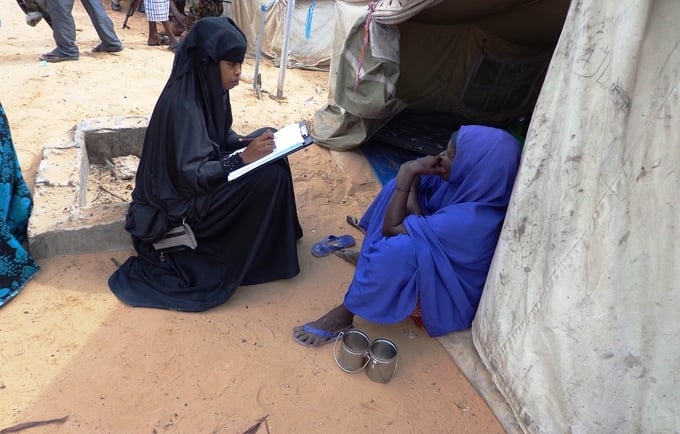The information generated by a population and housing census – numbers of people, their distribution, their living conditions and other key data – is critical for development. Without accurate data, policymakers do not know where to invest in schools, hospitals and roads. Those most in need remain invisible. Yet too many countries have outdated or inaccurate information about their populations.
A census is among the most complex and massive peacetime exercises a nation undertakes. It does not merely count people; it can also measure fertility, mortality and movement, helping to predict demographic trends. And it can uncover inequalities in employment, education and wealth.
UNFPA aims to make sure no country fails to carry out a census because of financial or technical constraints. UNFPA provides technical support during all stages of a national census, and helps ensure the data are widely utilized and disseminated for development.
How is the information used?

Today, with major demographic shifts occurring and attention focused on international development, accurate and timely data are more important than ever.
The unique advantage of the census is that it represents the entire statistical universe, down to the smallest geographical unit, of a country or region. Planners need this information for all kinds of development work, including: assessing demographic trends; analysing socio-economic conditions; designing evidence-based poverty-reduction strategies; monitoring and evaluating the effectiveness of policies; and tracking progress toward national and internationally agreed development goals.
The information also helps raise awareness about population issues among government decision-makers and the public at large. Additionally, a national census is often the only source of information for identifying forms of social, demographic or economic exclusion – such as inequalities by racial, ethnic, religious or other characteristics. The census also provides data on disadvantaged regions and vulnerable groups, such as the poor, the young, the old, people living with disabilities, and women and girls.
Censuses can empower local communities by giving them access to this critical data. And it can encourage participation in local decision-making by increasing knowledge of communities’ needs and by ensuring representation based on accurate numbers.
An enormous undertaking
A traditional population and housing census requires mapping an entire country, deciding what technologies should be employed, mobilizing and training legions of enumerators, conducting a major public awareness campaign, canvassing all households, collecting individual information, compiling hundreds of thousands – or millions – of completed questionnaires, monitoring procedures and results, and analysing, utilizing and disseminating the results.
Though it is a very laborious and costly operation, it is a vital one. Only a census can provide the fine-grained and accurate data needed by analysts and policymakers to make informed, evidence-based development policies. It is recommended that a national census be conducted every 10 years to make comparable information available. A series of censuses allow experts to assess the past, describe the present and estimate for the future.
Censuses are conducted in “rounds.” The 2010 census round took place between 2006 and 2015. The 2020 census round comprises census exercises taking place between 2015 and 2024.
The 2030 Agenda for Sustainable Development, adopted in 2015, has placed the highest priority on ensuring that “no one is left behind”, calling on national statistical systems to disaggregate national indicators and monitor and redress inequalities as a matter of human rights.The 2020 census round will be conducted in the context of the new commitments to identify and redress inequalities between and within countries, across a wide range of sustainable development indicators.
Challenges versus opportunities
Because so much depends on the data produced, the process can become highly charged and requires careful monitoring. And because a census exercise typically occurs once every decade, it is hard to retain expertise in national statistical offices between censuses. By the time a new census rolls around, many experienced demographers or statisticians have moved on to retirement or the private sector.
Census taking is also very costly. Creating partnerships with major stakeholders, including civil society and the private sector, is crucial for the successful implementation and continuity of censuses.
Conflict situations in many countries pose additional challenges, as well. And despite the essential role of census data in evidence-based development plans and poverty-reduction strategies,censuses face challenges in conduction during crisis situations and data is not always converted into information that is useful for designing the most cost-effective and accurately targeted policies – a challenge UNFPA works to address.
Despite those challenges, there are emerging opportunities; new and emerging technology solutions for census provide opportunity to improve the quality, cost effectiveness and timeliness of the census operation. Additionally, collaborative efforts between countries through South-South and triangular cooperation also provide opportunity for experience sharing and lesson learning between countries.
UNFPA in action
Supporting countries in the collection, analysis and dissemination of census data for development is a critical part of UNFPA's mandate.
UNFPA play key roles in coordinating technical and financial assistance for censuses. This support and guidance is as appropriate for country contexts; it can include providing opportunities for countries to exchange information on their 2010 round experiences, resource mobilization, the provision of chief technical advisers, training in technical communication and advocacy, operating publicity campaigns, as well as developing census budgets, road maps, promoting the full range of possible census methods; and providing guidance, as appropriate for country contexts, on choosing the most appropriate method(s) and technology options to use.and instruments such as questionnaires and manuals.
Last updated 28 May 2020.


